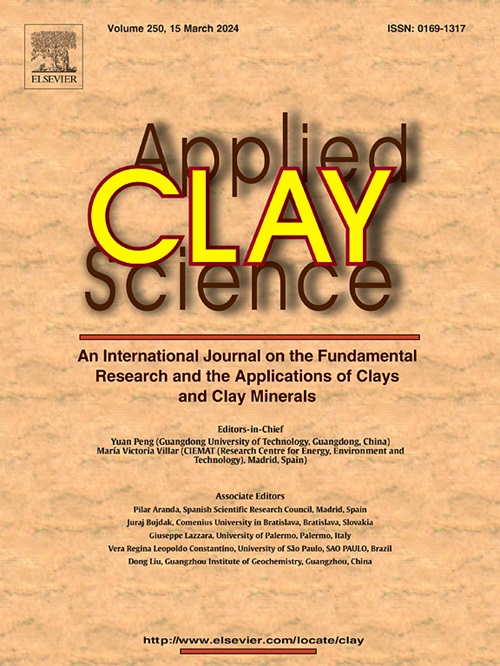Multi-functional nanoarchitectonics of allophane via addition reactions with acrylonitrile through C-O bond formation
IF 5.3
2区 地球科学
Q2 CHEMISTRY, PHYSICAL
引用次数: 0
Abstract
Organic functional groups, such as the cyano group (-CN), were introduced onto the Allophane (Allo) surface through addition reactions to achieve precise control over Allo surface properties. Polyacrylonitrile (PAN), Allo and surface-treated Allo were characterized using FT-IR, XRD, XPS and 27Al NMR techniques. It was found that an additional reaction occurs between Allo and acrylonitrile (AN), forming a C-O covalent bond between the unsaturated carbon‑carbon bonds (C=C) of AN and the aluminum hydroxyl groups (Al-OH) on the Allo surface. This reaction constructs an (Al)O-C(C) structure, rearranging the electron density in the aluminum‑oxygen octahedral units, thereby affecting the short-range quasi-crystalline structure within Allo. Concurrently, -CN groups were attached to the Allo surface, while alkenes such as acrylic acid and sodium acrylate introduced organic functional groups like -COOH and -CONH2 onto the Allo surface. This approach provides a new method for grafting functional groups onto the Allo surface and a novel strategy to modify the surface properties of Allo to obtain multifunctional, high-performance Allo nanocomposite materials.

求助全文
约1分钟内获得全文
求助全文
来源期刊

Applied Clay Science
地学-矿物学
CiteScore
10.30
自引率
10.70%
发文量
289
审稿时长
39 days
期刊介绍:
Applied Clay Science aims to be an international journal attracting high quality scientific papers on clays and clay minerals, including research papers, reviews, and technical notes. The journal covers typical subjects of Fundamental and Applied Clay Science such as:
• Synthesis and purification
• Structural, crystallographic and mineralogical properties of clays and clay minerals
• Thermal properties of clays and clay minerals
• Physico-chemical properties including i) surface and interface properties; ii) thermodynamic properties; iii) mechanical properties
• Interaction with water, with polar and apolar molecules
• Colloidal properties and rheology
• Adsorption, Intercalation, Ionic exchange
• Genesis and deposits of clay minerals
• Geology and geochemistry of clays
• Modification of clays and clay minerals properties by thermal and physical treatments
• Modification by chemical treatments with organic and inorganic molecules(organoclays, pillared clays)
• Modification by biological microorganisms. etc...
 求助内容:
求助内容: 应助结果提醒方式:
应助结果提醒方式:


